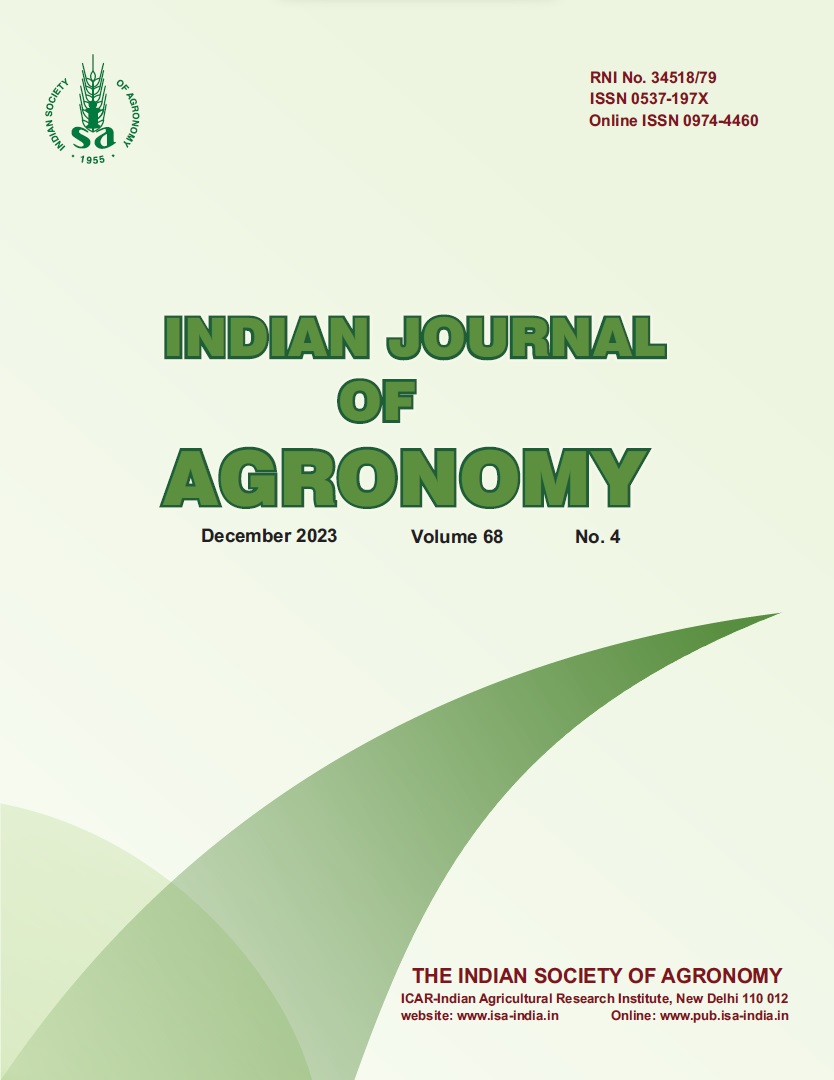Assessment of precise nutrient management through nutrient expert on productivity and profitability of zero-till maize
DOI:
https://doi.org/10.59797/ija.v68i4.5458Keywords:
Conservation agriculture, Maize, Nutrient expert, Nutrient uptake, Precision crop nutrition, Profit, YieldAbstract
An experiment was conducted during the rainy (kharif) season of 2017 and 2018 at the ICAR-Indian Agricultural Research Institute, New Delhi, to evaluate the effect of tillage and nutrient-management options on yield, nutrient uptake, residual soil-fertility status, and enzymatic activities in maize (Zea mays L.). The zero-tillage with crop residue at 3.5 t/ha (ZT + R) and conventional tillage with crop residue at 3.5 t/ha (CT + R) enhanced the grain yield (6.2–17.0%) of maize compared to CT without residue (4.40 t/ha). High cost of cultivation was recorded in CT + R (44.8 × 103 `/ha), while high net returns were found in ZT + R (37.6 × 103 `/ha). In ZT + R, the addition of wheat residue enhanced N, P, and K uptake in grain by 19.41, 12.81 and 13.92%, respectively over CT. Available N (182 kg/ha), available P (13.8 kg/ha), and exchangeable K (318 kg/ha) were found highest with ZT + R. Nutrient expert system (NES) enhanced the grain yield (5.30 t/ha) and net returns (43.0 × 103 `/ha) compared to no application of nutrients (control) (3.35 t/ha and 17.9 × 103 `/ha) and recommended dose of fertilizer (RDF) (4.70 t/ha and 34.8 × 103 `/ha). Higher activity of dehydrogenase (DHA) (25.9 TPF μg/g/h) and microbial biomass C (130 μg/g) were found with NES. An increase of 57.96–58.4% in N uptake was found with NES over RDF (80.0 kg/ha). The nutrient expert system (NES) and 125% of RDF left higher amount of residual N, P and K in soil than the control. Overall, nutrient expert system under zero-tillage with crop residue at 3.5 t/ha can increase the productivity and profitability in maize.References
Cassida, L.E., Klein, J.R., Santoro, D.A. and Thomas, S. 1964. Soil dehydrogenase activity Soil Science 98(6): 371–376.
FAO. 2022. www.databasefao.org accessed on 12.10.2022
ICAR-IIMR. 2020. Annual Report 2020, ICAR-Indian Institute of Maize Research, Punjab Agricultural University Campus, Ludhiana, Punjab
Pampolina, M.F., Witt, C., Pasuquin, J.M., Johnston, A. and Fisher, M.J. 2012. Development approach and evaluation of the nutrient expert software for nutrient management in cereal crops. Computers and Electronics in Agriculture 88: 103–110.
Pasuquin, J.M., Pampolino, M.F., Witt, C., Dobermann, A., Oberthur, T., Fisher, M.J. and Inubushi, K. 2014. Closing yield gaps in Southeast Asia through site-specific nutrient management. Field Crop Research 156: 219–230.
Sepat, S. and Rana, D.S. 2013. Effect of double no-till and permanent raised beds on productivity, profitability and physical properties of soil in maize (Zea mays)–wheat (Triticum aestivum) cropping system Indian Journal of Agronomy 58(4): 469–473.
Sepat, S., Bana, R.S., Meena, S.L. and Rana, D.S. 2019. Assessment of conservation agriculture and intercropping practices for enhanced productivity and profitability in maize (Zea mays). Indian Journal of Agricultural Sciences 89(4): 714–720.
Sepat, S., Sharma, A.R., Kumar, D. and Das, T.K. 2015. Effect of conservation agriculture practices on productivity and sustainability of pigeonpea (Cajanus cajan)–wheat (Triticum aestivum) cropping system in Indo-Gangetic plains of India. Indian Journal of Agricultural Sciences 85(2): 212–216.
Sepat-Seema, Behera, U.K., Sharma, A.R., Das, T.K. and Bhattacharyya, R. 2014. Productivity, organic carbon and residual soil fertility of pigeonpea–wheat cropping system under varying tillage and residue management. Proceedings of the National Academy of Sciences, India Section B: Biological Sciences 84(3): 561–571.
Singh, V., Kaur, R., Singh, B., Brar, B.S. and Kaur, A. 2016. Precision nutrient management: a review. Indian Journal of Fertilizers 12(11): 15–17.
Vance, E.D., Brookes, P.C. and Jenkinson, D.S. 1987. An extraction method for measuring soil microbial biomass C. Soil Biology and Biochemistry 19(6): 703–707.






